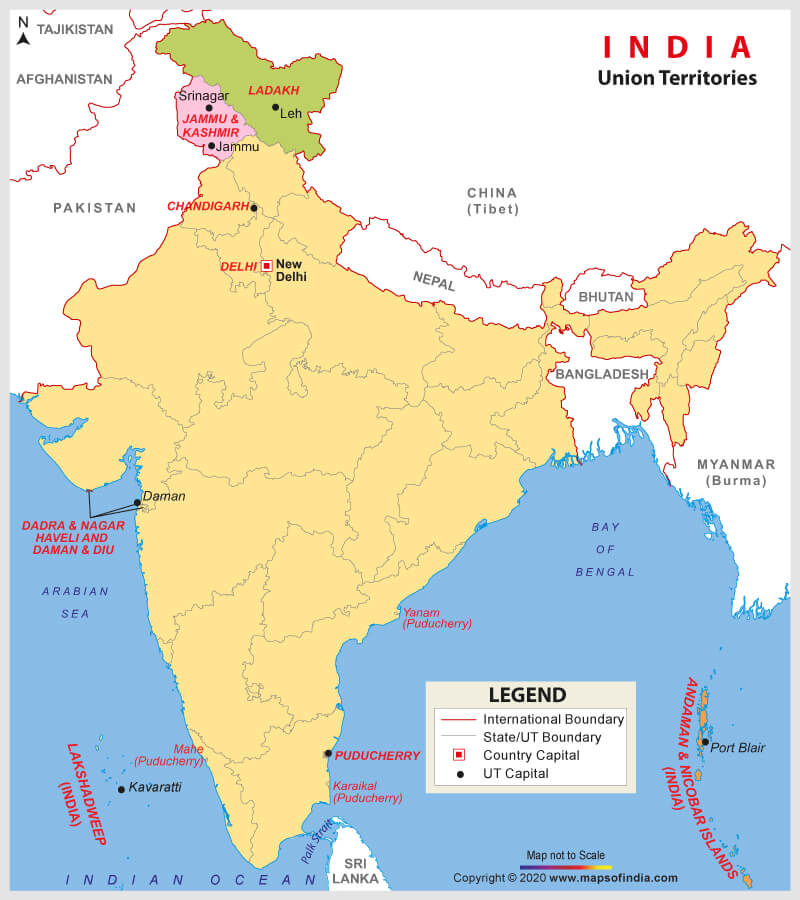Structural Fragility of Union Territories
2021 MAR 1
Mains >
Constitution > Union and States > Union territories
IN NEWS:
- The fall of congress led government in Puducherry has exposed the structural fragility of Union Territories (UTs) as units of the Indian federation, making it easier for powerful operators in the political system to destabilise them.
UNION TERRITORIES (UTs):
- According to Article 1, the territory of India can be classified into three categories:
- Territories of the states
- Union territories
- Territories that may be acquired by the Government of India at any time
- The states are the members of the federal system in India and share a distribution of power with the Centre.
- The union territories are those areas which are under the direct control and administration of the Central government. Hence, they are also known as Centrally Administered Territories.
- The Union territories have been created for a variety of reasons:
- Political and administrative consideration. Eg: Delhi and Chandigarh.
- Cultural distinctiveness. Eg: Puducherry, Dadra and Nagar Haveli and Daman and Diu.
- Strategic importance. Eg: Andaman and Nicobar Islands and Lakshadweep.
- Special treatment and care of the backward and tribal people. Eg: Mizoram, Manipur, Tripura and Arunachal Pradesh which later became states.

ADMINISTRATION OF UTs:
- Even though all the union territories belong to one category, there is no uniformity in their administrative system.
- Every union territory is administered by the President acting through an administrator appointed by him.
- The President can specify the designation of an administrator: it may be Lieutenant Governor or Chief Commissioner or Administrator.
- Union Territories of Puducherry (in 1963) and Delhi (in 1992) are provided with a legislative assembly4 and a council of ministers headed by a chief minister.
- The Parliament can make laws on any subject of the three lists (including the State List) for the union territories. This power of Parliament also extends to Puducherry and Delhi, which have their own local legislatures.
CONCERNS OVER ADMINISTRATION OF UTs:
- Composition of legislature: Legislature of UTs is a body that is elected, or partly elected and partly nominated. There can be a legislature without a Council of Ministers or a Council of Ministers without a legislature, both of which are a conceptual absurdity.
- Issue of nomination: Unlike the nomination of members to the Rajya Sabha, no qualifications are laid down for nomination of members to UT legislatives. This leaves the field open for the Union government to nominate anyone irrespective of whether he or she is suitable.
- Undue influence of Central government: No Union government really likes the idea of an autonomous government in the UTs and therefore tries to control it through the administrator and constitutional provision. This is most severe when the UT is ruled by a different political party.
- Administrator’s power: The Government of Union Territories Act, 1963 and Article 239 AA vests some powers in the administrator. However, the precise contours of the sharing of powers between the administrator and the elected government is a grey area, resulting in frequent conflicts.
- Subjective interpretation of terms: In the event of referring any matter to the President, the Court ruled that the administrator must adhere to the constitutional principles of collaborative federalism, constitutional balance and the concept of constitutional governance. However, these terms are very wide and subject to different interpretations.
- Overlapping jurisdiction: The extend of powers of executive over municipal corporations and parastatals like Electricity Board and Transport Authority is still a grey area. Hence, conflicts between centre, state and parastatals are frequent.
WAY FORWARD:
- Clear-cut legislations: Amendments to the various legal provisions, such as Government of Union Territories Act, 1963 and Article 239AA, needs to be made so as to bring forth clear demarcation of power among the various governance agencies and as well as ensure cordial cooperation among them.
- Greater autonomy for state government: In all possible areas, the elected governments of UTs should be given autonomy in decision making and implementation, as it derives its power from the people.
- More powers for local governments: City-government should have a hand in the running of the local municipal bodies. The functions of the parastatals should be merged in the ULB.
- Dispute resolution mechanism: There is a need to establish a credible and institutionalised dispute-resolution mechanism to deal with the recurring conflicts in UT administration and foster cooperative federalism in the country.
- Responsible politics: mature discussions and concrete efforts between stakeholders that looks beyond short-term political gains is the key. The political class will have to take measures to get the better of the predatory instincts of political parties, through constitutional or other means.
PRACTICE QUESTION:
Q. The existence of Union Territories constitutes a unique case of departure from federalism in India. Elaborate, with special reference to the case of National Capital Region?
